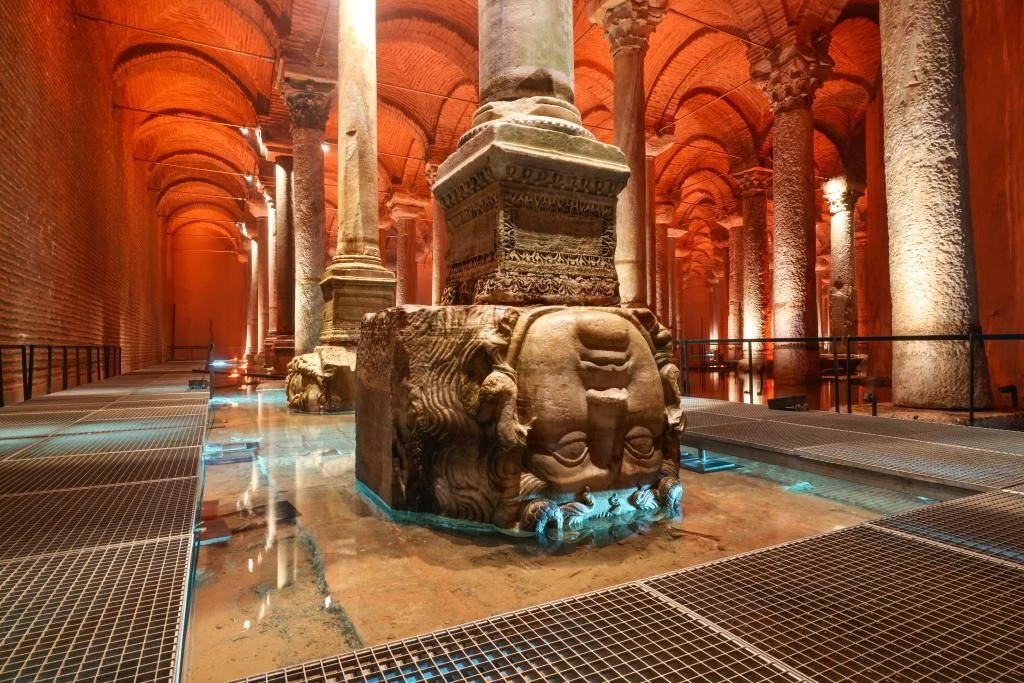10 Best Attractions to visit in Europe




1. Basilica Cistern, Turkey (Istanbul):
The Basilica Cistern, nestled beneath the bustling streets of Istanbul, stands as a captivating testament to ancient engineering and mystique. This subterranean marvel, also known as the Yerebatan Sarnıcı, was constructed in the 6th century during the Byzantine era to provide a reliable water supply for the city. Its vast underground chambers, supported by a forest of recycled Roman and Byzantine columns, create an eerie yet enchanting atmosphere. Illuminated by soft, ethereal lighting, the Basilica Cistern offers visitors a unique journey through time, where the rhythmic drip of water echoes the secrets of Istanbul’s rich history. This hidden gem remains a must-visit attraction, evoking a sense of wonder and awe in all who explore its depths.
- Prague Castle, Czech Republic:
Dominating the skyline of the enchanting city of Prague, Prague Castle is a historical treasure trove that narrates the story of Czech history. This colossal complex, one of the world’s largest, has been a focal point of power for over a millennium. Its origins trace back to the 9th century, and it has witnessed the reign of kings, emperors, and presidents. At its heart lies the magnificent St. Vitus Cathedral, a masterpiece of Gothic architecture. The castle’s courtyards, gardens, and palaces beckon visitors to explore its regal splendor while offering breathtaking panoramic views of the city below. Prague Castle is a living embodiment of Czech heritage and a must-visit destination for those seeking to immerse themselves in the nation’s rich history.
- Eiffel Tower, France (Paris):
The Eiffel Tower, an iconic symbol of Paris and France, is a marvel of engineering and artistry. Gustave Eiffel’s masterpiece was completed in 1889 for the World’s Fair and has since become a global landmark. Ascending its iron lattice structure reveals panoramic views of Paris that captivate millions of visitors annually. By day or night, the Eiffel Tower’s enduring charm beckons travelers to appreciate its intricate design, history, and its role as an enduring beacon of French culture and innovation.
- Colosseum, Italy (Rome):
The Colosseum, also known as the Flavian Amphitheatre, stands as a testament to the grandeur and architectural prowess of ancient Rome. Completed in AD 80, this colossal arena once hosted epic gladiator battles and chariot races. Its iconic elliptical shape, tiered seating, and colossal scale continue to astound visitors. Exploring the Colosseum’s passages and imagining the roar of the crowd is a journey through time, revealing the enduring legacy of Roman engineering and entertainment.
- Acropolis, Greece (Athens):
The Acropolis, perched high above Athens, is the epitome of classical Greek architecture and civilization. Dominated by the Parthenon, this ancient citadel holds a profound historical and cultural significance. Dedicated to the goddess Athena, the Parthenon’s Doric columns and intricate friezes are masterpieces of ancient artistry. The Acropolis offers a glimpse into the birthplace of democracy, philosophy, and Western civilization, making it an essential destination for anyone seeking to understand the roots of Western culture.
- Sagrada Familia, Spain (Barcelona):
Antoni Gaudí’s Sagrada Família in Barcelona is an architectural marvel that transcends time and convention. This basilica, under construction since 1882, defies categorization with its unique blend of Gothic and Art Nouveau styles. Its organic forms and intricate facades, adorned with colorful mosaics, invite contemplation and admiration. Inside, the soaring nave and surreal design elements create a spiritual atmosphere. The Sagrada Família is a testament to Gaudí’s genius and a symbol of Barcelona’s artistic and cultural legacy.
- Buckingham Palace, UK (London):
Buckingham Palace, the official residence of the British monarch in London, is a symbol of royal splendor and tradition. The Changing of the Guard ceremony attracts crowds, while the grand facade and Victoria Memorial provide iconic photo opportunities. The State Rooms, open to the public during the summer, showcase opulent furnishings and artworks. Buckingham Palace represents the enduring monarchy and is a must-visit site to experience British regal history and pageantry.
- Venice Canals, Italy:
Venice, often called the “Floating City,” is renowned for its intricate network of canals. These waterways serve as the lifeblood of the city, winding past historic palaces, churches, and vibrant neighborhoods. Visitors can navigate the canals by gondola, vaporetto, or simply by strolling along picturesque bridges. Venice’s unique charm, romantic ambiance, and timeless beauty make it a world-famous destination, where the interplay of water and architecture creates an unforgettable experience.
- Neuschwanstein Castle, Germany:
Neuschwanstein Castle, perched atop a hill in Bavaria, Germany, is a fairy tale come to life. Commissioned by King Ludwig II in the 19th century, its design is inspired by romanticism and medieval lore. The castle’s turrets, spires, and breathtaking mountain backdrop make it a vision of architectural fantasy. Often associated with the Disney logo, Neuschwanstein Castle welcomes visitors to explore its opulent interiors and offers panoramic views of the surrounding countryside.
- Charles Bridge, Czech Republic (Prague):
The Charles Bridge in Prague is a timeless masterpiece of medieval bridge construction. Stretching across the Vltava River, it connects the city’s historic Old Town with the Prague Castle district. The bridge’s 30 statues, often cloaked in history and legends, line its sides. Strolling along the Charles Bridge, with its cobblestone surface and captivating views of Prague Castle, is an enchanting journey through the heart of the Czech capital’s history and culture.
Recent Posts
Announcement of Corporate Rebranding: IAT (Singapore) Technology Pte. Ltd. Transitions to IAS Global Pte. Ltd.
SINGAPORE - Media OutReach Newswire - 2 April 2025 - IAT (Singapore) Technology Pte. Ltd.…
The Henderson Art Garden Is Now Open to Public
HONG KONG SAR - Media OutReach Newswire - 1 April 2025 - Henderson Land Development…
iSON Xperiences Appoints Ricardo Langwieder as Chief Sales Officer to Drive Growth and Innovation
DUBAI, UNITED ARAB EMIRATES - EQS Newswire - 1 April 2025 - iSON Xperiences (www.iSONXperiences.com),…
Ascott powers up loyalty programme, Ascott Star Rewards, with enhanced member features to treble membership by 2028
Refreshes user interface and boosts personalisation on ASR mobile app to enhance ease of use…
Record-breaking Global Participation: Final Call to Join the TERA-Award by 9 April
HONG KONG SAR - Media OutReach Newswire – 1 April 2025 - The 4th TERA-Award…
iSON Xperiences Appoints Ricardo Langwieder as Global Chief Sales Officer to Drive Growth and Innovation
DUBAI, UNITED ARAB EMIRATES - EQS Newswire - 1 April 2025 - iSON Xperiences (www.iSONXperiences.com),…


